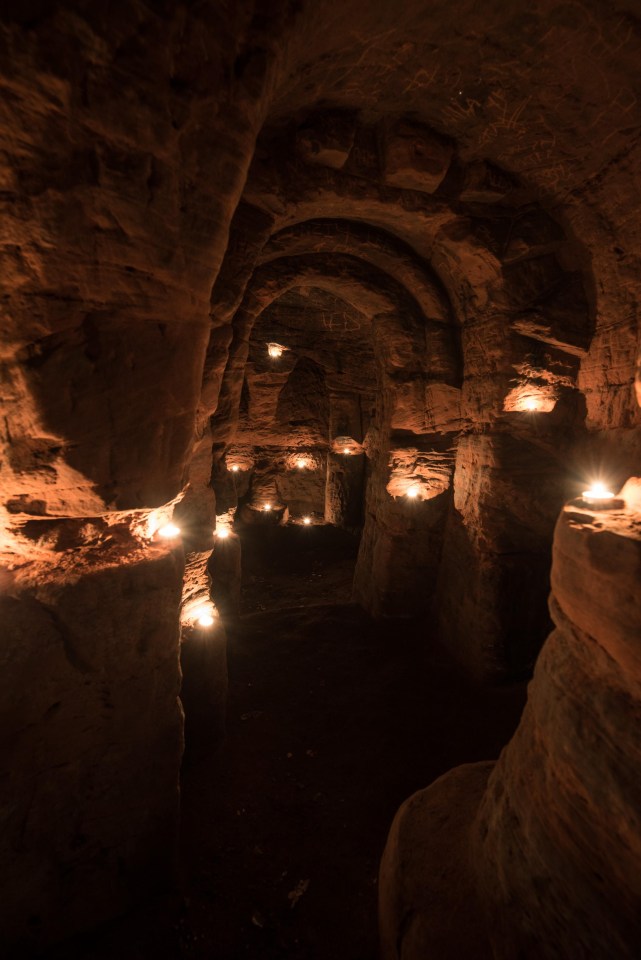THIS unassuming rabbit hole hides an incredible secret – the entrance to a mysterious cave network used by the Knights Templar 700 years ago.
Hidden in a field in Shropshire the ancient site contains beautifully carved arches, a font and a network of walkways.
HOLE LOT OF MYSTERY This ‘regular’ rabbit hole hides an incredible secret – the entrance to a mysterious cave network used by the Knights Templar 700 years ago
Beautiful carved arches and a network of walkways form part of ancient site underneath Shropshire field
By Carl Stroud
7th March 2017
The Sun
THIS unassuming rabbit hole hides an incredible secret – the entrance to a mysterious cave network used by the Knights Templar 700 years ago.
Hidden in a field in Shropshire the ancient site contains beautifully carved arches, a font and a network of walkways.
 Unassuming rabbit hole in Shropshire field conceals entrance to incredible cave network
Unassuming rabbit hole in Shropshire field conceals entrance to incredible cave network
 The ancient sapce was used by the Knights Templar 700 years ago
The ancient sapce was used by the Knights Templar 700 years ago
 The network contains beautifully carved arches, a font and a series of walkways
The network contains beautifully carved arches, a font and a series of walkways

The entrance to the network can be found in a farmer’s field
Photographer Michael Scott visited the site – barely three feet beneath a farmer’s field – after seeing a video about it online.
The 33-year-old said: “I traipsed over a field to find it, but if you didn’t know it was there you would just walk right past it.
“It’s probably less than three feet underground, so it’s more into the field than under it.
“Considering how long it’s been there it’s in amazing condition. It’s like an underground temple.”
Michael added the cave was quite cramped and those nearing six feet tall would have to bend down to fit in.
He said: “I had to crouch down and once I was in it was completely silent.
“There were a few spiders in there but that was it.
“It was raining so the slope down was quite sludgy but inside the cave was bone dry.”
The Knights Templar were a medieval religious order that fought in the Crusades.
 Photographer Michael Scott visited the site after seeing a video about it online
Photographer Michael Scott visited the site after seeing a video about it online

Photographer Michael told of his surprise at how well-preserved the site was

The cave is quite cramped and requires anyone taller than six foot to crouch
 Hidden away from the elements the interior of the network is bone dry
Hidden away from the elements the interior of the network is bone dry
https://www.thesun.co.uk/news/3029431/rabbit-hole-holds-incredible-secret/
Hidden in a field in Shropshire the ancient site contains beautifully carved arches, a font and a network of walkways.
HOLE LOT OF MYSTERY This ‘regular’ rabbit hole hides an incredible secret – the entrance to a mysterious cave network used by the Knights Templar 700 years ago
Beautiful carved arches and a network of walkways form part of ancient site underneath Shropshire field
By Carl Stroud
7th March 2017
The Sun
THIS unassuming rabbit hole hides an incredible secret – the entrance to a mysterious cave network used by the Knights Templar 700 years ago.
Hidden in a field in Shropshire the ancient site contains beautifully carved arches, a font and a network of walkways.
 Unassuming rabbit hole in Shropshire field conceals entrance to incredible cave network
Unassuming rabbit hole in Shropshire field conceals entrance to incredible cave network  The ancient sapce was used by the Knights Templar 700 years ago
The ancient sapce was used by the Knights Templar 700 years ago  The network contains beautifully carved arches, a font and a series of walkways
The network contains beautifully carved arches, a font and a series of walkways 
The entrance to the network can be found in a farmer’s field
Photographer Michael Scott visited the site – barely three feet beneath a farmer’s field – after seeing a video about it online.
The 33-year-old said: “I traipsed over a field to find it, but if you didn’t know it was there you would just walk right past it.
“It’s probably less than three feet underground, so it’s more into the field than under it.
“Considering how long it’s been there it’s in amazing condition. It’s like an underground temple.”
Michael added the cave was quite cramped and those nearing six feet tall would have to bend down to fit in.
He said: “I had to crouch down and once I was in it was completely silent.
“There were a few spiders in there but that was it.
“It was raining so the slope down was quite sludgy but inside the cave was bone dry.”
The Knights Templar were a medieval religious order that fought in the Crusades.
 Photographer Michael Scott visited the site after seeing a video about it online
Photographer Michael Scott visited the site after seeing a video about it online 
Photographer Michael told of his surprise at how well-preserved the site was

The cave is quite cramped and requires anyone taller than six foot to crouch
 Hidden away from the elements the interior of the network is bone dry
Hidden away from the elements the interior of the network is bone dryhttps://www.thesun.co.uk/news/3029431/rabbit-hole-holds-incredible-secret/









